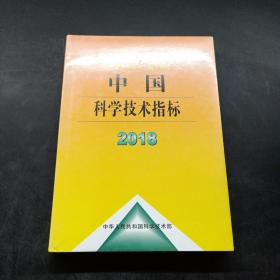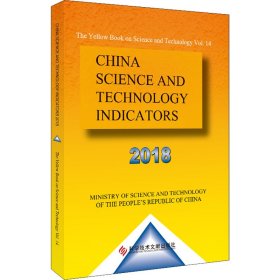
中国科学技术指标2018(英文)
正版现货,品相完整,套书只发一本,多版面书籍只对书名
¥ 71.49 4.8折 ¥ 150 九品
仅1件
北京海淀
认证卖家担保交易快速发货售后保障
作者中华人民共和国科学技术部
出版社科学技术文献出版社
出版时间2021-11
版次1
装帧其他
上书时间2024-06-28
- 在售商品 暂无
- 平均发货时间 23小时
- 好评率 暂无
- 最新上架
商品详情
- 品相描述:九品
图书标准信息
- 作者 中华人民共和国科学技术部
- 出版社 科学技术文献出版社
- 出版时间 2021-11
- 版次 1
- ISBN 9787518983353
- 定价 150.00元
- 装帧 其他
- 开本 16开
- 纸张 铜版纸
- 【内容简介】
-
PREFACE
Science and technology (S&T) indicators are quantitative measurements of S&T activity, aimed
at accurately reflecting the status of S&T activity and its role and impact on society and the
economy. They serve as a basis for S&T policy development and evaluation of S&T policy
effectiveness. Countries and international organizations are placing increasing importance on
S&T indicators as a key tool of S&T policy development and analysis.
China Science and Technology Indicators, jointly prepared by the Ministry of Science and
Technology of the People’s Republic of China together with other relevant ministries and
agencies of the State Council, has been published biennially since 1993 as a government yellow
book on S&T development. China Science and Technology Indicators 2018 is the 14th volume
of the yellow book.
This volume mainly draws on S&T statistics and relevant economic and social statistics as of
the end of 2017. It provides a comprehensive picture of China’s S&T development since the
implementation of the Outline of the National Plan for Medium- and Long-Term Scientific
and Technological Development (2006-2020) and the Science, Technology and Innovation
Development Plan for the 13th Five-Year Plan Period, reveals the main characteristics of
China’s S&T activity as a driving force of the national economic and social transformation and
development, and reflects the historical process of China gearing itself to enhance indigenous
innovation capabilities and build an innovation-driven nation.
This volume continues the overall structural stability of the biennially updated publication
in terms of framework and indicator system. Besides a systematic analysis of China’s S&T
development on the basic dimensions, including S&T human resources, R&D expenditure, S&T
output, S&T activity of main sectors of performance (enterprises, higher education institutions
and government research institutions), high-technology industry, regional S&T progress,
scale and structure of S&T development, and public understanding of and attitudes towards
science and technology, capturing the main characteristics of China’s S&T activity, this volume
features some degree of expansion in structure and content by highlighting the trend analysis
of S& T indicators based on historical comparison and international comparison. For historical
comparison, it puts China’s S&T development in recent years in the context of its efforts to
build an innovation-driven nation with a view to identifying the historical trends and dynamics
of S&T development. As a highlight in international comparison, it compares China with major
developed countries and emerging economies on internationally comparable indicators in order
to position and characterize China’s S&T development internationally. Due to data availability
constraints, this report does not include data on Hong Kong, Macao and Taiwan unless
otherwise specified. The Editorial Board wishes to acknowledge its gratitude for the guidance
and assistance provided by authorities, experts and scholars of government agencies and
institutions including the Ministry of Science and Technology, China Association for Science
and Technology, Chinese Academy of Sciences, National Natural Science Foundation of China,
State Administration of Foreign Exchange, Ministry of Education, National Bureau of Statistics,
State Intellectual Property Office, National Development and Reform Commission, Ministry of
Finance, General Administration of Customs, and State Administration of Science, Technology
and Industry for National Defense, and would appreciate any comments and feedback from
readers. - 【目录】
-
CONTENTS
Overview 1
Chapter 1 Human Resources in Science and Technology 15
Section 1 Overview of Human Resources in Science and Technology 15
Section 2 R&D Personnel 16
Section 3 Cultivation of Human Resources in Science and Technology 21
Chapter 2 Research and Development Expenditure 27
Section 1 Overview of R&D Expenditure 27
Section 2 Structure of R&D Expenditure 31
Section 3 Sources and Destinations of R&D Funds 35
Section 4 Government Science and Technology Expenditure 37
Chapter 3 Output of Science and Technology Activity 40
Section 1 S&T Papers 40
Section 2 Patents 50
Section 3 Domestic Technology Transfer 59
Chapter 4 Research and Development Activity and Innovation of Enterprises 64
Section 1 R&D Activity of Enterprises 64
Section 2 R&D Activity of Industrial Enterprises 68
Section 3 R&D Collaboration and Technology Acquisition of Industrial Enterprises 78
Chapter 5 Science and Technology Activity of Higher Education Institutions 84
Section 1 Overview of Higher Education Institutions 84
Section 2 R&D Organizations and Personnel in Higher Education Institutions 87
Section 3 R&D Expenditure of Higher Education Institutions 90
Section 4 Higher Education R&D Output and Transformation 95
Chapter 6 Science and Technology Activity of Government Research Institutes 100
Section 1 Overview of Government Research Institutes 100
Section 2 R&D Personnel 102
Section 3 R&D Expenditure of Research Institutes 105
Section 4 Output and Achievement Transfer of S&T Activity 112
Chapter 7 Development of High-technology Industry 118
Section 1 High-technology Industry 118
Section 2 High-technology Products 124
Section 3 National High-technology Industrial Development Zones 127
Section 4 Venture Capital 132
Chapter 8 Regional Science and Technology Indicators 137
Annex Tables 148
Annex Table 1-1 Overview of China’s HRST stock (2006-2017) 148
Annex Table 1-2 R&D personnel of selected countries (regions) 150
Annex Table 1-3 R&D personnel of selected countries (regions) by sector of
performance 151
Annex Table 1-4 Number of undergraduate and postgraduate students (2005-2017) 152
Annex Table 1-5 Number of Chinese students studying abroad and returning home
from overseas (1990-2017) 153
Annex Table 2-1 R&D expenditure (2000-2017) 154
Annex Table 2-2 Distribution of R&D expenditure by type of activity and sector
of performance (2000-2017) 155
Annex Table 2-3 Structure of R&D expenditure by sector of performance (2017) 156
Annex Table 2-4 Central and local government S&T expenditures and their proportions
(2000-2017) 157
Annex Table 2-5 R&D expenditure of selected countries (regions) (2005-2017) 158
Annex Table 2-6 R&D intensity of selected countries (regions) (2005-2017) 159
Annex Table 2-7 R&D expenditure of selected countries (regions) by source of funding
and sector of performance (2017) 161
Annex Table 2-8 R&D expenditure of selected countries (regions) by type of R&D
activity 162
Annex Table 2-9 R&D expenditure of selected countries by type of expenditure 163
Annex Table 3-1 Number of SCI-indexed Chinese papers (2005-2017) 164
Annex Table 3-2 Number of Chinese SCI papers by discipline and type of institution
(2005-2017) 165
Annex Table 3-3 China’s efficiency of R&D expenditure and R&D personnel by
output of SCI papers (2000-2015) 165
Annex Table 3-4 Number of resident and non-resident patent applications and grants by
type (2005-2017) 166
Annex Table 3-5 Number of non-resident invention patent applications by country
(2005-2017) 168
Annex Table 3-6 Number of non-resident invention patent grants by country
(2005-2017) 169
Annex Table 3-7 Resident service and non-service invention patent grants (2005-2017) 170
Annex Table 3-8 Number of resident and non-resident patents in force by type
(2006-2017) 170
Annex Table 3-9 Number of PCT applications by country (2005-2017) 172
Annex Table 3-10 Number of triadic patent families by country (2005-2016) 173
Annex Table 3-11 Turnover of national technology market contracts (2007-2017) 174
Annex Table 3-12 National technology market contracts (2017) 175
Annex Table 4-1 Enterprise R&D personnel and R&D expenditure (2000-2017) 176
Annex Table 4-2 Sources and composition of enterprise R&D expenditure
(2010-2017) 177
Annex Table 4-3 Enterprise intramural R&D expenditure (2004-2017) 178
Annex Table 4-4 R&D intensity of industrial enterprises (2004-2017) 178
Annex Table 4-5 Experimental development expenditure of industrial enterprises and as
a percentage of R&D expenditure (2004-2017) 179
Annex Table 4-6 Industrial enterprise intramural R&D expenditure by industry (2017) 179
Annex Table 4-7 Extramural R&D expenditure of industrial enterprises by industry
(2017) 181
Annex Table 4-8 Collaborative R&D projects of industrial enterprises by partner type
(2017) 183
Annex Table 4-9 Expenditure on technology acquisition of industrial enterprises
(2000-2017) 183
Annex Table 5-1 R&D activity of regular HEIs (2005-2017) 184
Annex Table 5-2 Higher education R&D expenditure of selected countries (2017) 185
Annex Table 5-3 Ratio of higher education R&D expenditure to GDP of selected
countries (2005-2017) 186
Annex Table 5-4 Higher education papers, patents and technology market contracts
(2005-2017) 186
Annex Table 6-1 Number of research institutes (2005-2017) 187
Annex Table 6-2 Personnel of research institutes (2005-2017) 188
点击展开
点击收起
相关推荐
— 没有更多了 —

















以下为对购买帮助不大的评价